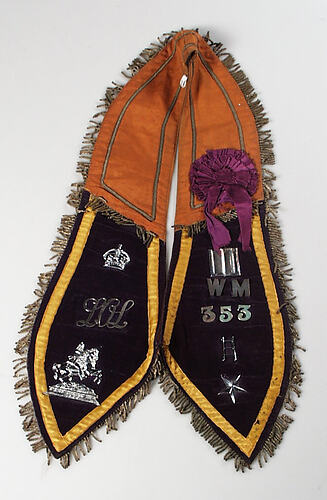Summary
Loyal Orange Institution ceremonial collar used in Melbourne, Victoria, Australia, circa 1900.
The Loyal Orange Institution is a Protestant society first formed in Ireland in 1795 to defend the rights of Ulstermen. The first Orange Lodge in Victoria was founded in 1843, following a sectarian protest in Elizabeth Street Melbourne over the election of a Protestant candidate to the Legislative Council Lodge processions stirred sectarian violence in 1845, 1846, 1896 and 1897.
Physical Description
Collar - violet coloured velvet and coarse orange satin. Low half of collar is velvet trimmed with yellow satin ribbon at edges. On R of collar are chrome badges : (from top) crown initials "L.O.L. (Loyal Orange Lodge), and figure of King William III on horseback with his name and date (1690) underneath. On the L (from top) are badges of : Holy Bible, initials "W. M., numbers 3, 5, 3, a ladder and a 5 pointed star. The top part of the collar is of orange satin trimmed with gold cord. On the L is a rosette of gathered purple satin ribbon. Collar is edged with gold fringing. Badges are removable and intended to be able to be interchanged.
Significance
In Victoria, the Lodge, after its re-organisation in 1864, attracted ultra-Protestants of all backgrounds, not only from Ireland. By the 1890s, there were 169 branches in Victoria, engaged in political lobbying for mainstream Protest- ant issues like temperance, Sunday observance, opposition to state aid for church schools, and opposition to any expansion of the political influence of Roman Catholics. The monthly meetings had an element of secrecy, as members wore regalia and followed a simple ritual. No Catholics could join. The Lodge was never a Friendly Society, but had links with the Protestant Alliance Friendly Society. Women were admitted to Lodges in 1903.
More Information
-
Collection Names
-
Collecting Areas
-
Acquisition Information
Donation from Manchester Unity - Independent Order of Oddfellows (MU IOOF), 31 Mar 1989
-
Place Used
Melbourne, Greater Melbourne, Victoria, Australia, circa 1900
-
Classification
-
Category
-
Discipline
-
Type of item
-
overall dimensions
56 cm (Height)
-
Exhibition Collection Management
360 mm (Width), 580 mm (Height)
width taken collar open flat, of both lapels; height as would hang around neck
-
References
Of Interest to Orangemen.
-
Keywords

